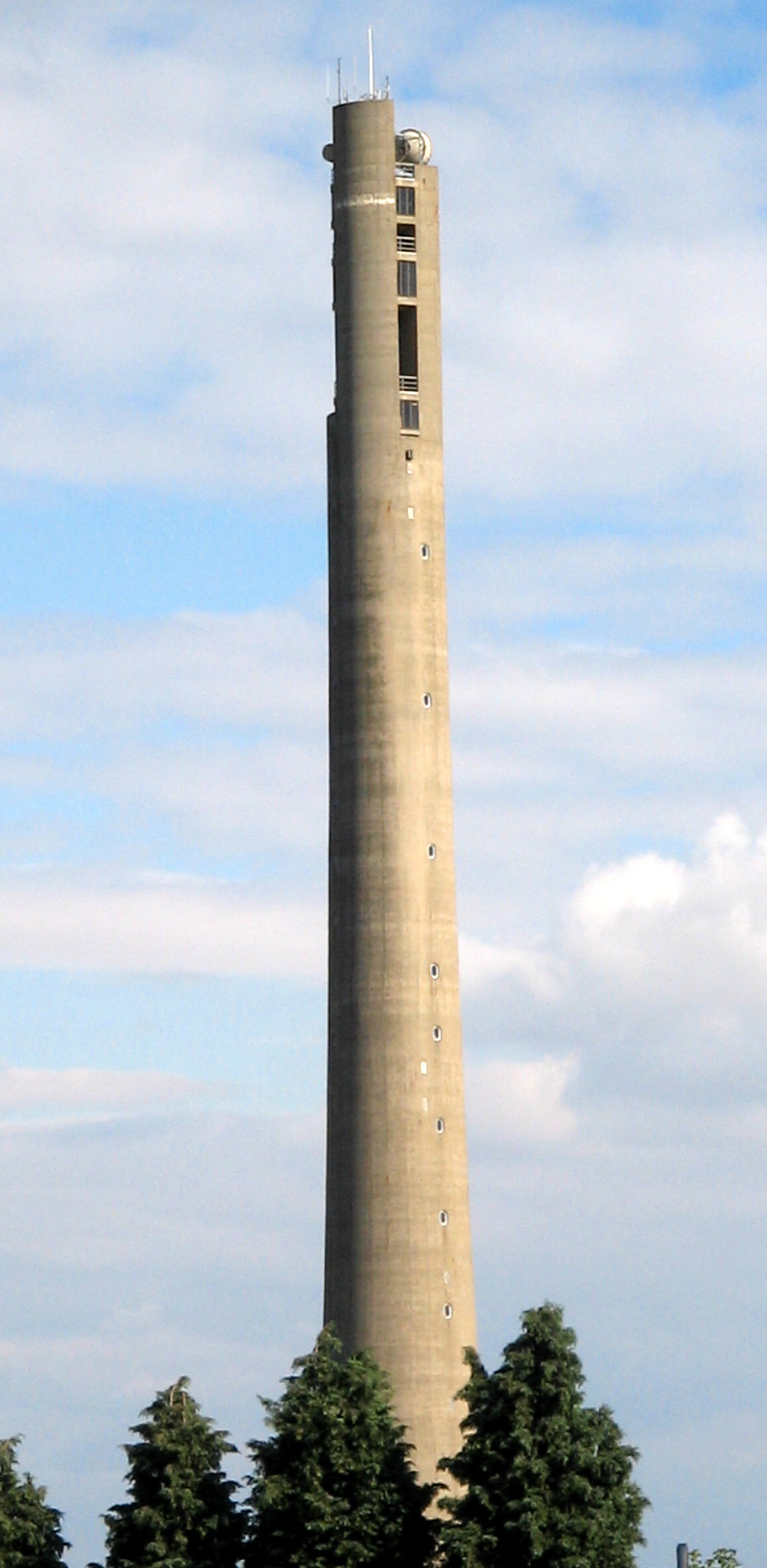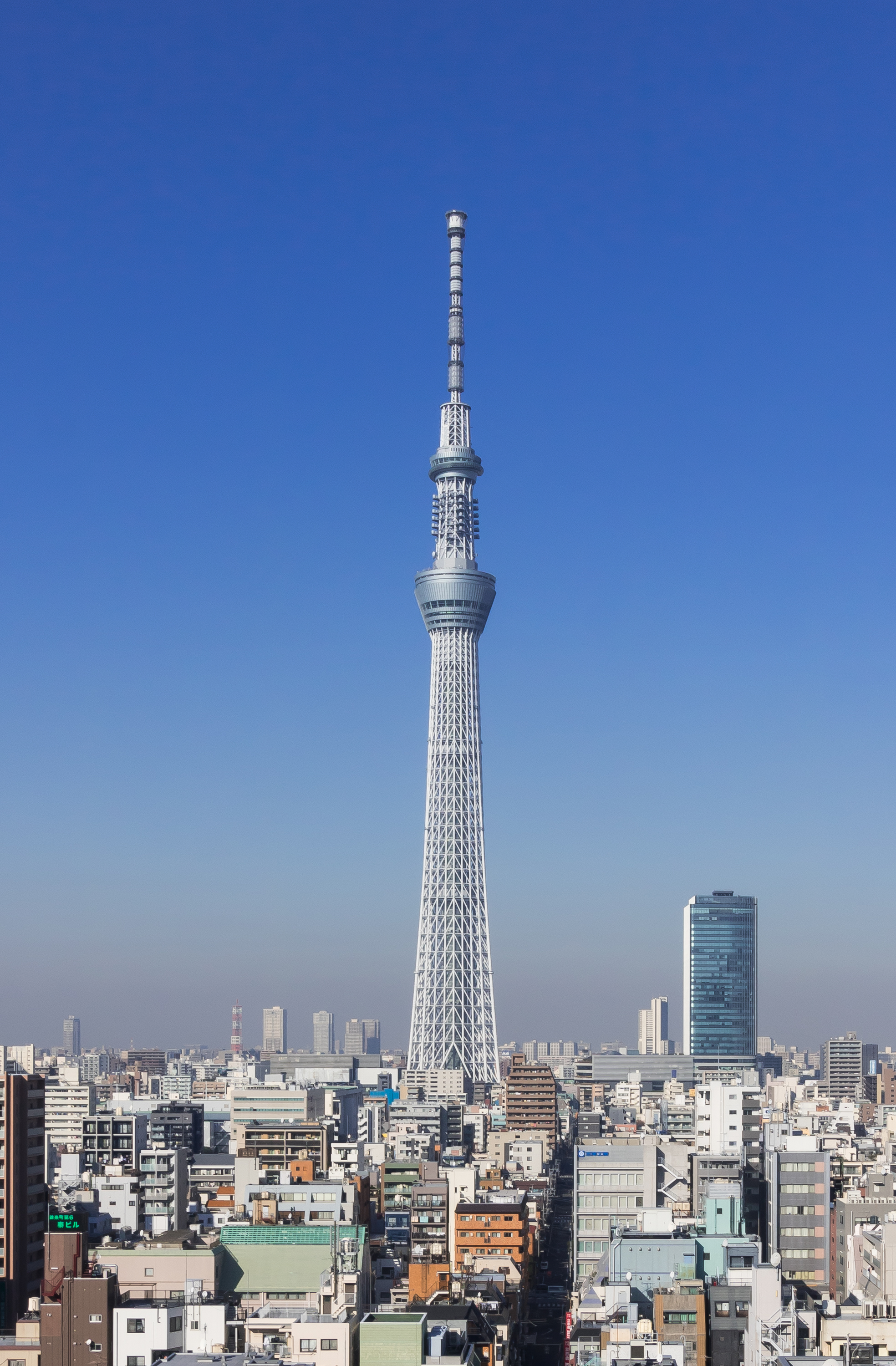|
Express Lift Tower
The National Lift Tower (previously called the Express Lift Tower) is a lift-testing tower built by the Express Lift Company (a lifts division of the General Electric Company (GEC)) off the Weedon Road in Northampton, England. The structure was commissioned in 1978 with construction commencing in 1980, and was officially opened by Queen Elizabeth II on 12 November 1982. It has been a Grade II Listed Building since 1997. The tower can be viewed from Arbury Hill, the highest point in Northamptonshire. Background The site The tower is in St James End, west of Northampton town centre. The area is named after Northampton Abbey, an Augustinian monastery dedicated to St James, which was founded in 1104–05. When the former Express Lift factory, which included the lift-testing tower, was redeveloped for housing in 1999–2000, excavations were carried out to determine the location and remains of any parts of the abbey. A cemetery of burials was excavated during winter 2000–01 ... [...More Info...] [...Related Items...] OR: [Wikipedia] [Google] [Baidu] |
Northamptonshire
Northamptonshire (; abbreviated Northants.) is a county in the East Midlands of England. In 2015, it had a population of 723,000. The county is administered by two unitary authorities: North Northamptonshire and West Northamptonshire. It is known as "The Rose of the Shires". Covering an area of 2,364 square kilometres (913 sq mi), Northamptonshire is landlocked between eight other counties: Warwickshire to the west, Leicestershire and Rutland to the north, Cambridgeshire to the east, Bedfordshire to the south-east, Buckinghamshire to the south, Oxfordshire to the south-west and Lincolnshire to the north-east – England's shortest administrative county boundary at 20 yards (19 metres). Northamptonshire is the southernmost county in the East Midlands. Apart from the county town of Northampton, other major population centres include Kettering, Corby, Wellingborough, Rushden and Daventry. Northamptonshire's county flower is the cowslip. The Soke of Peterborough fal ... [...More Info...] [...Related Items...] OR: [Wikipedia] [Google] [Baidu] |
Elevators
An elevator or lift is a cable-assisted, hydraulic cylinder-assisted, or roller-track assisted machine that vertically transports people or freight between floors, levels, or decks of a building, vessel, or other structure. They are typically powered by electric motors that drive traction cables and counterweight systems such as a hoist, although some pump hydraulic fluid to raise a cylindrical piston like a jack. In agriculture and manufacturing, an elevator is any type of conveyor device used to lift materials in a continuous stream into bins or silos. Several types exist, such as the chain and bucket elevator, grain auger screw conveyor using the principle of Archimedes' screw, or the chain and paddles or forks of hay elevators. Languages other than English, such as Japanese, may refer to elevators by loanwords based on either ''elevator'' or ''lift''. Due to wheelchair access laws, elevators are often a legal requirement in new multistory buildings, especially w ... [...More Info...] [...Related Items...] OR: [Wikipedia] [Google] [Baidu] |
Towers Completed In 1982
A tower is a tall Nonbuilding structure, structure, taller than it is wide, often by a significant factor. Towers are distinguished from guyed mast, masts by their lack of guy-wires and are therefore, along with tall buildings, self-supporting structures. Towers are specifically distinguished from buildings in that they are built not to be habitable but to serve other functions using the height of the tower. For example, the height of a clock tower improves the visibility of the clock, and the height of a tower in a fortified building such as a castle increases the visibility of the surroundings for defensive purposes. Towers may also be built for observation tower, observation, leisure, or telecommunication purposes. A tower can stand alone or be supported by adjacent buildings, or it may be a feature on top of a larger structure or building. Etymology Old English ''torr'' is from Latin ''turris'' via Old French ''tor''. The Latin term together with Greek language, Greek τύ ... [...More Info...] [...Related Items...] OR: [Wikipedia] [Google] [Baidu] |
Grade II Listed Buildings In Northamptonshire
Grade most commonly refers to: * Grade (education), a measurement of a student's performance * Grade, the number of the year a student has reached in a given educational stage * Grade (slope), the steepness of a slope Grade or grading may also refer to: Music * Grade (music), a formally assessed level of profiency in a musical instrument * Grade (band), punk rock band * Grades (producer), British electronic dance music producer and DJ Science and technology Biology and medicine * Grading (tumors), a measure of the aggressiveness of a tumor in medicine * The Grading of Recommendations Assessment, Development and Evaluation (GRADE) approach * Evolutionary grade, a paraphyletic group of organisms Geology * Graded bedding, a description of the variation in grain size through a bed in a sedimentary rock * Metamorphic grade, an indicatation of the degree of metamorphism of rocks * Ore grade, a measure that describes the concentration of a valuable natural material in the surrounding ... [...More Info...] [...Related Items...] OR: [Wikipedia] [Google] [Baidu] |
Towers In Northamptonshire
A tower is a tall structure, taller than it is wide, often by a significant factor. Towers are distinguished from masts by their lack of guy-wires and are therefore, along with tall buildings, self-supporting structures. Towers are specifically distinguished from buildings in that they are built not to be habitable but to serve other functions using the height of the tower. For example, the height of a clock tower improves the visibility of the clock, and the height of a tower in a fortified building such as a castle increases the visibility of the surroundings for defensive purposes. Towers may also be built for observation, leisure, or telecommunication purposes. A tower can stand alone or be supported by adjacent buildings, or it may be a feature on top of a larger structure or building. Etymology Old English ''torr'' is from Latin ''turris'' via Old French ''tor''. The Latin term together with Greek τύρσις was loaned from a pre-Indo-European Mediterranean language, ... [...More Info...] [...Related Items...] OR: [Wikipedia] [Google] [Baidu] |
List Of Towers
Several extant building fulfill the engineering definition of a tower: "a tall human structure, always taller than it is wide, for public or regular operational access by humans, but not for living in or office work, and are ''self-supporting'' or ''free-standing'', which means no guy-wires for support." This definition excludes continuously habitable buildings and skyscrapers as well as radio and TV masts. Also excluded because they are not designed for public or regular operational access are bridge towers or pylons, wind turbines, chimneys, transmission towers, sculptures and most large statues and obelisks. Towers are most often built to use their height for various purposes, and can stand alone or as part of a larger structure. Some common purposes are for telecommunications, and as a viewing platform. The Tokyo Skytree, completed in February 2012, is , making it the tallest tower, and third-tallest free-standing structure in the world. Entirely self-supported towers ... [...More Info...] [...Related Items...] OR: [Wikipedia] [Google] [Baidu] |
Terry Wogan
Sir Michael Terence Wogan (; 3 August 1938 – 31 January 2016) was an Irish radio and television broadcaster who worked for the BBC in the UK for most of his career. Between 1993 and his semi-retirement in December 2009, his BBC Radio 2 weekday breakfast programme ''Wake Up to Wogan'' regularly drew an estimated eight million listeners. He was believed to be the most listened-to radio broadcaster in Europe."Wogan's run – the King of banter finally goes blankety blank" by Kim Bielenberg, ''Irish Independent'', 12 September 2009 Wogan was a leading media personality in Ireland and Britain from the late 1960s, and was often referred to as a "national treasure". [...More Info...] [...Related Items...] OR: [Wikipedia] [Google] [Baidu] |
Tim Hunkin
Tim Hunkin (born Timothy Mark Trelawney Hunkin, 27 December 1950 in London) is an English engineer, cartoonist, writer, and artist living in Suffolk, England. He is best known for creating the Channel Four television series ''The Secret Life of Machines'', in which he explains the workings and history of various household devices. He has also created museum exhibits for institutions across the UK, and designed numerous public engineering works, chiefly for entertainment. Hunkin's works are distinctive, often recognisable by his unique style of papier-mâché sculpture (made from unpainted newsprint), his pen and ink cartoons, and his offbeat sense of humour. Education Hunkin graduated in engineering from Gonville and Caius College, Cambridge. Work and career Hunkin's ''Under the Pier Show'' at Southwold Pier, England, is a penny arcade featuring a number of humorous, coin-operated machines of his creation. Attractions include the "Autofrisk" (a device that simulates the experi ... [...More Info...] [...Related Items...] OR: [Wikipedia] [Google] [Baidu] |
The Secret Life Of Machines
''The Secret Life of Machines'' is an educational television series presented by Tim Hunkin and Rex Garrod, in which the two explain the inner workings and history of common household and office machinery. According to Hunkin, the show's creator, the programme was developed from his comic strip ''The Rudiments of Wisdom'', which he researched and drew for the ''Observer'' newspaper over a period of 14 years. Three separate groupings of the broadcast were produced and originally shown between 1988 and 1993 on Channel 4 in the United Kingdom, with the production subsequently broadcast on The Learning Channel and the Discovery Channel in the U.S. Contents Each of the ''Secret Lifes individual series covers a particular set of machines. The first addresses household appliances, while the second includes devices used outside the home, such as the car. The third series examines the contraptions and gadgets used in a modern office. Each episode was given an individual title, such ... [...More Info...] [...Related Items...] OR: [Wikipedia] [Google] [Baidu] |
Educational Television
Educational television or learning television is the use of television programs in the field of distance education. It may be in the form of individual television programs or dedicated specialty channels that is often associated with cable television in the United States as Public, educational, and government access (PEG) channel providers. There are also adult education programs for an older audience; many of these are instructional television or "telecourse" services that can be taken for college credit, such as the Open University programs on BBC television in the UK. Many children's television series are educational, ranging from dedicated learning programs to those that indirectly teach the viewers. Some series are written to have a specific moral behind every episode, often explained at the end by the character that learned the lesson. In the social aspects of television, several studies have found that educational television has many advantages. The Media Awareness Networ ... [...More Info...] [...Related Items...] OR: [Wikipedia] [Google] [Baidu] |
Channel 4
Channel 4 is a British free-to-air public broadcast television network operated by the state-owned enterprise, state-owned Channel Four Television Corporation. It began its transmission on 2 November 1982 and was established to provide a fourth television service in the United Kingdom. At the time, the only other channels were the television licence, licence-funded BBC One and BBC Two, and a single commercial broadcasting network ITV (TV network), ITV. The network's headquarters are based in London and Leeds, with creative hubs in Glasgow and Bristol. It is publicly owned and advertising-funded; originally a subsidiary of the Independent Broadcasting Authority (IBA), the station is now owned and operated by Channel Four Television Corporation, a public corporation of the Department for Digital, Culture, Media and Sport, which was established in 1990 and came into operation in 1993. Until 2010, Channel 4 did not broadcast in Wales, but many of its programmes were re-broadcast ... [...More Info...] [...Related Items...] OR: [Wikipedia] [Google] [Baidu] |






